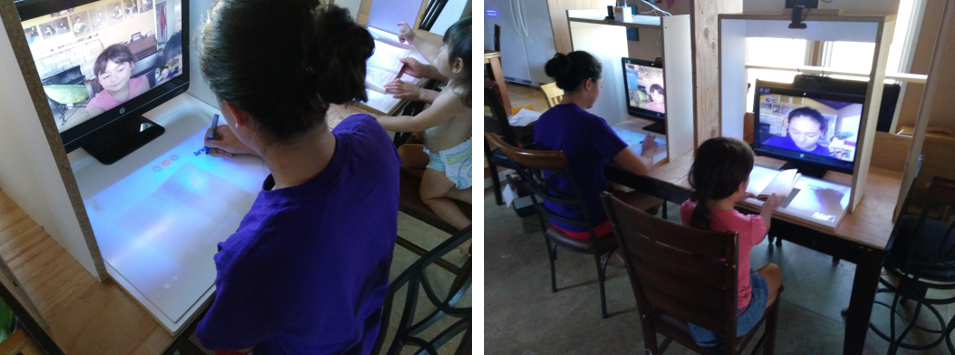APPEAR:
Advanced Personal Presence Emulated Augmented
Reality
Young H. Cho, Ph.D., Darin Gray, Ed.D., Jesus Gonzalez, M.P.A., Andrew Goodney, Ph.D., Kaelyn Cho
Open Acceleration Systems Research, University of
Southern California, Boys and Girls Club of America - Mar Vista Garden Branch

Current state of the APPEAR Platform (cost:
$400/unit - target: $250/unit) for the Boys and Girls Club (Culver City, CA)

APPEAR Platform Evaluation (Future Integration)
Video 1
and NSF 2026 Idea Machine Competition Entry (One of 33 Finalist out of 800
entries)
Video 2:
APPEAR VR Environment Learning Video Demonstration
Video 3:
APPEAR VR Environment Learning Video Demonstration
Video 4:
APPEAR VR Environment Learning Video Demonstration
Video 5:
APPEAR Desktop Environment Video Demonstration
In 2020, the world responded with unprecedented restrictions placed on its
citizens in an attempt to slow the spread of the Coronavirus. These measures
involve strict lockdowns of various industries and services, including
educational institutions. While many schools in the United States were forced
to migrate their educational activities online, more than 30% of US students
could not adopt the change. Therefore, instructional quality suffered an
immense degradation during this pandemic. Foreseeing that the current and
potential pandemics will change the way the world operates, our team feels
compelled to preserve the education of current and future generations.
Decades of hands-on instruction and mentoring experience with low-income
communities have made our team aware of the dire need for educational
assistance, even before the pandemic. Despite the diversity of backgrounds in
our team, we have all come to understand that the key aspect of teaching and
learning is the human relationship of a teacher with a student. Despite this
common understanding by many teachers, we have observed that the main goal of
new educational platforms is to minimize or eliminate human relations,
preferring efficient information transfer through computers over human
teacher-to-student interactions. This trend may seem like a logical direction
for the future. Still, expanding urbanization and limited human resource has
shown to be ineffective compared to human-to-human instruction.
Therefore, our team of researchers, instructors, and directors from Open
Acceleration Systems Research, USC Computer Sciences and Electrical Engineering
departments, K-12 STEM Outreach Center, and Boys and Girls Club - Mar Vista
Garden branch has been working collaboratively on the development of an online
education platform called Advanced Personal Presence Emulated Augmented Reality
(APPEAR) for the last three years. APPEAR aims to provide a cost-effective and
self-sustaining mechanism for primary and secondary school students to receive
effective one-on-one instruction.
Unlike other modern educational
platforms, the focus of our innovation has been developing effective methods of
establishing, enhancing, and accelerating human relationships with re-purposed
commodity-off-the-shelf components. We have found that the academic experience
has largely dismissed this approach to developing an educational platform as
lacking innovation. However, our designs, development, and testing processes
for several APPEAR prototypes, including the state-of-the-art devices for
Virtual and Augmented Reality, have taught us that the most challenging task of
the platform development was not necessarily the development and expert utility
of the new technology. Instead, the most difficult but important reading is
extracting and understanding the critical aspects of human interactions
experienced during teaching sessions and then accentuating them to enhance the
realism of the relationship with given hardware, software, and communication
interfaces.
We propose to build a low-cost prototype of the APPEAR
platform that will adapt existing commodity components and infrastructures,
providing a turnkey platform with educational extensions currently missing in
existing video conferencing systems while simultaneously providing innovative
functions that will increase the realism of human presence, encouraging student
accountability, and assist in enhancing teacher-to-student-to-parents/guardians
relationships.
Our extensive research/industry record and our piloted
virtual and augmented reality prototypes showcased in the above video
demonstrate that our team does not lack innovation and capabilities. However,
we need to design and develop a low-cost, upgradable base prototype to address
the severe deficiencies in existing education platforms and quickly disseminate
them to the end users.
Once the initial deployment and exposure are
completed, we will extend the features to increase the realism of human presence
with the given APPEAR hardware (i.e., virtual localization and presence
simulation of multiple students and dynamic perspective adjustments based on
user postures - in other words, TV appears as a window to the other side of
reality), allow optimal adjustment of a teacher to student ratio (i.e.,
increased internship opportunity for student teachers and hierarchical
organization of teachers, student teachers, and students), enable effective
teacher training and certifications (i.e., online mentorship tools for teacher
training approved by USC school of education), and increase teaching efficiency
with automated content analysis and assistance for the instructors (i.e., A.I.
-driven content recognition/analysis system to provide choices of standard
instruction approaches in real-time.)


